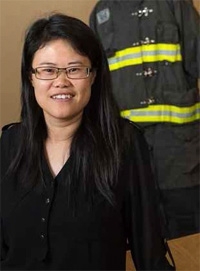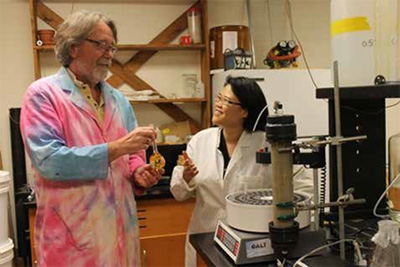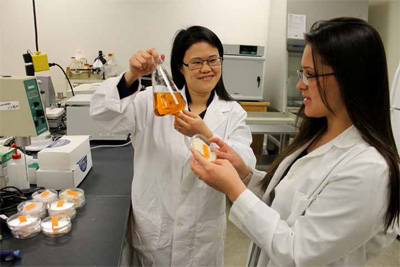 Dr. Yan Vivian Li,
Dr. Yan Vivian Li,
Assistant Professor in Fiber Science,
Department of Design and Merchandising, College of Health and Human Sciences,
Associate Faculty, School of Biomedical Engineering, Colorado State University
Prof.William Sanford, an associate professor of Geosciences at CSU and Vivian Li collaborated to understand what goes on in the sub-surface during oil recovery and the fracking process. Hydraulic fracturing of wells has caused a political firestorm in recent years, as Colorado residents have questioned the health and safety risks of injecting chemicals into the ground to free oil and natural gas. There is still debate about whether these chemicals are harming the environment and some question where the chemicals go after injection, fearing they may be contaminating groundwater supplies. They are developing modified “smart” nano particles known as smart tracers that could sense high pH levels or the presence of hydraulic fracking chemicals.

An interview with Prof. Yan Vivian Li, PhD
What are smart/intelligent medical textiles?
Smart textiles are the first generation wearable technology that can predict biological signals such as heart rate or temperature using a integrated electrical sensor device. The Vital Vest is one of the first such textile garments used for medical applications. The challenge for these wearable textiles is that the bio sensors are integrated into the clothing, making it difficult for wearability and can be easily damaged during laundering.
To solve this challenge, we are doing new research using nanotechnology for textiles that shrinks the size of the device, enhancing the wearability. The next stage of research into wearables is being done on the raw material by manipulating smart polymers to respond to biological responses.
Using this method, we are adapting smart polymers, for instance, that can respond to bacteria by changing color. This can be used for medical bandages for early detection of infection in wound care and is a new direction for polymer and fiber chemists in the future. So our goal is to manipulate materials at the nanoscale level; this emerging research eliminates the washing issue for wearables because it is built into the raw material of the fabric within the fibers.
How do you collaborate with other research teams involved in Nanotechnogy research and are they world-wide across a wide range of disciplines?
We work with physicists, cell biologists, other chemists and materials scientists. That is one of the great things about nanotechnology, you can apply it almost anywhere to any field. A lot of our collaborations consist of my lab developing a new tool or method and then working with colleague with a really interesting sample.
What is the research you are doing with Nano spheres?
The particle is designed to change color as it experiences different reactions based on chemicals that it encounters. We use fluorescent colors to trace various chemicals that stick to the nano spheres such as oil. When hydraulic fracturing is done, half of the oil remains hidden, and using this method, the nano-sphere can detect the hidden oil for more efficiency and cost effectiveness. This method also works well in harsh environments.
The Nano spheres can also be used to engineer a particle to find contaminants in ground water and surface water. The nano sphere is trained to respond to certain chemicals and will change color when they are detected, allowing scientists to measure the amounts. This method applies surface chemistry on small nano particles and is in early stage research for several potential applications.
 Professor Yan Vivian Li (left) and her graduate student (right), Daniela Jankovska working with a carbon nanoparticle solution in their lab.
Professor Yan Vivian Li (left) and her graduate student (right), Daniela Jankovska working with a carbon nanoparticle solution in their lab.
How might your research be applied to renewable energy and sustainability?
We are researching methods to create nano particles that selectively absorb lithium ions on surface water where it is commonly found especially in South American lakes or in sea water. We are developing nano particles that can reproduce the lithium over a large surface area that gives a very high absorption of lithium and reproducing it economically for use in batteries.
How do you use Atomic Force Microscopes in your work?
We use the Park Systems AFM to detect different characterization and morphology of the fibers. The AFM feature that enhances our research is the ability to detect mechanical properties such as hardness which cannot be done using other microscopy. With AFM, we can quantify other properties as well as take nanoscale measurements, which is important in our examination of fibers and polymers.
Can you explain how you are using the Funding from the National Institute of Food and Agriculture and USDA to create smart hygiene wipes?
Smart hygiene wipes are made by non-woven fabrics created by electrospinning a mixture of polydiacetylene (PDA) and polyethylene oxide (PDA/PEO). The electrospun PDA/PEO nanofibers will be examined in AFM for fiber morphology and mechanical properties.
What advances do you see in the future for Scientific Fiber Research using Nano Technology?
Nanotechnology is able to significantly enhance fiber properties including mechanical properties, flame-resistant properties, and breathability. Novel fibers will be continuously benefited from nanotechnology for advanced applications in medical textiles, military textiles, and technical and industrial textiles.




